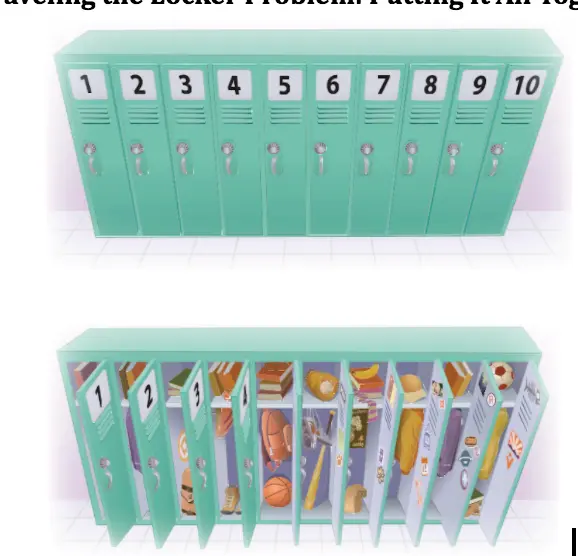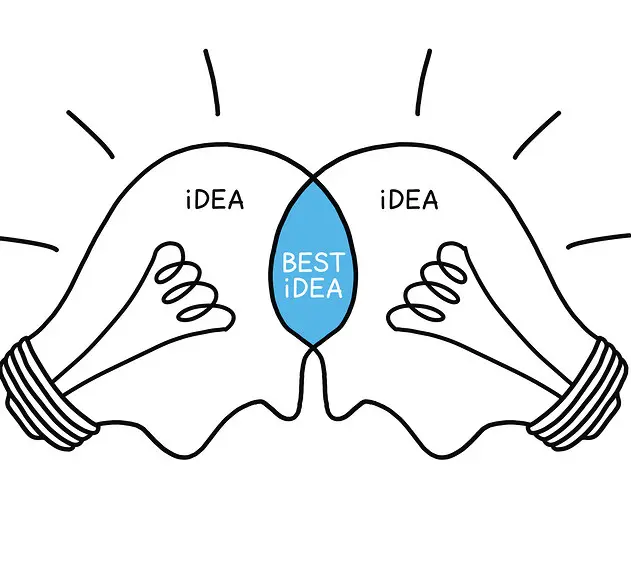Subject Area/ Grade: Math/ 6th Grade
1,000 lockers line a long high school hallway. Students try to answer a Math problem following these rules: The 1st student opens every locker door. The 2nd student changes the state of every 2nd door. The 3rd student changes the state of every 3rd door. The 4th student changes the state of every 4th door, etc. ‘Changes the state’ means that the student opens the locker door if it is closed and closes the door if it is open. “What Math problem do you think students are trying to answer?” To present their solution, students can: create a story book; make a video simulating the situation; create a powerpoint presentation; create a song describing the process in finding the answer.
Goals
Students will work collaboratively to formulate their own question for the Locker Problem and find a solution to that question. They will make a creative output to present their process and the solution. Options will include but are not limited to:
1. Creating a story book
2. Making a video or a vlog
3. Creating a powerpoint presentation
4. Creating a Math song
5. Or any other creative ways that will present their solution
Content Area and Standards
Unit 1: Prime Time
Standards:
1. 1.1 Scholarship Math NS: I can compute fluently with multi-digit numbers and find common factors and multiples.
2. 2.0 Scholarship: I can come to class prepared and complete all assigned work.
3. 5.0 Creativity: I can demonstrate creativity by displaying originality and style.
Activity
The project revolves around the Locker Problem and is given to the students at the end of Unit 1: Prime Time. The unit is focused on the concepts of multiples, factors, prime and composite numbers and square numbers in real life.
Here is the situation that will be presented to the students:
Part 1: Introduction/ Videos
Strategy: Think-Group-Share
Procedure:
1. Pose the question: “How can a confusing question spark someone’s interest in finding the solution to a problem?”
2. Show the video of Richard Serra’s Confusing Questions video
3. Group students in break out rooms where they share out their thoughts and record their responses in a document that is available in their Google classroom.

“How can a confusing question spark someone’s interest in finding the solution to a problem?”
Write your responses in the document below.
Student 1
Name:
Student 2
Name:
Student 3
Name:
Student 4
Name:
Strategy: Word Cloud
Procedure:
1. Show Wynton Marsalis’ Discipline and Practice video
2. On a PearDeck Slide, ask students to write one word that would complete the sentence:
“ When the task gets tough and challenging, we need ____________ to achieve our goal.”
1. Copy the slide in wordclouds.com so students can see the most common answer.
2. Have a class share out about student noticings.
Part 2: Brainstorming
Strategy: Noticings and Wonderings
Procedure:
1. Present the picture below.

2. Ask students to write down their Noticings and Wonderings on a Pear Deck slide.
I notice …..
I wonder ….
3. Present the situation about the lockers
The Situation:
1,000 lockers line a long hallway at Westfalls High. Students were creating trying to answer a Math problem following the following rules:
a. The 1st student opens every locker door.
b. The 2nd student changes the state of every 2nd door.
c. The 3rd student changes the state of every 3rd door.
d. The 4th student changes the state of every 4th door.
And so on!
Changes the state means that the student opens the locker door if it is closed and closes the door if it is open.
1. Ask the question: “What Math problem do you think students are trying to answer?”
2. Set up students in breakout rooms as they brainstorm for possible questions/problems.
3. They will create a list of possible problems and choose one that they think is the most probable or the question they would like to explore.
4. The question they will choose will become the problem they will answer for the project.

BRAINSTORMING DOCUMENT
1. List all possible questions or Math problems that the students were trying to answer based on the given situation
2. Record all your ideas in this document.
3. As a group, choose the question that you would like to explore. That would become your focus question for this project.
4. The question they will choose will become the problem they will answer for the project.
POSSIBLE QUESTIONS:
QUESTION WE WOULD LIKE TO EXPLORE
Part 3: Strategizing
1. Students will work together in solving their chosen problem. They can use any method or strategy as long as they are explicitly describing the process involved. They can use or design:
2. Charts
3. Tables
4. Diagrams
Part 4: Presenting their solution
1. Students can:
2. Create a story book
3. Make a video simulating the situation
4. Create a powerpoint presentation
5. Create a song describing the process in finding the answer
Joy2Learn Artists /Videos that Support Project
1. Richard Serra’s Confusing Questions video
2. Wynton Marsalis’ Discipline and Practice video
Art Forms that May Be Included
1. Graphic organizers (tables, graphs, charts, etc.) to help students in their thinking process
2. Possible output ideas:
3. story books/ comic strips
4. videos
5. powerpoint presentations
6. songs
Connections to Students Passion Areas and Interests
The options for their final output are based on students’ interests in writing, video making, arts, and music.
Materials Needed
Because this will be done online and remotely, a laptop or tablet is a must.
Assessment
RUBRIC:
Standard
1. Building Foundation Skills
2. Grade Level Mastery
3. Approaching Grade Level
4. Above Grade Level
2.0 Scholarship:
I can come to class prepared and complete all assigned work.
No output is turned in or is submitted more than 2 days late.
Project output is incomplete although turned in on time or is submitted 1-2 days after the due date.
Project output is completed, and it is submitted on time.
Packet is completed and is submitted before the final due date.
1.1 Scholarship Math NS:
I can compute fluently with multi-digit numbers and find common factors and multiples.
All mathematics connections are made incorrectly.
Shows no understanding in applying the concepts of multiples, factors, prime and composite numbers and square numbers in real life.
All mathematics connections are made correctly some of the questions.
Shows little understanding in applying the concepts of multiples, factors, prime and composite numbers and square numbers in real life.
All mathematics connections are made correctly for all questions.
Shows adequate understanding in applying the concepts of multiples, factors, prime and composite numbers and square numbers in real life.
All mathematics connections are made correctly all questions
AND
Connections to other concepts or subjects are present.
Shows sufficient understanding in applying the concepts of multiples, factors, prime and composite numbers and square numbers in real life.
5.0 Creativity:
I can demonstrate creativity by displaying originality with value and style.
Students produce visually appealing representations of their thinking.
Students produce high-quality, visually appealing representations of their thinking.
Student work is organized in a way that reveals the underlying structure of the problem.
Timeline
The students will be given 2 weeks to work on this project
Other Notes
Continue looking and exploring at different platforms and apps that can help in the presentation of this project.
1. Padlet
2. Flipgrid
3. An app that would help students create a story book online

